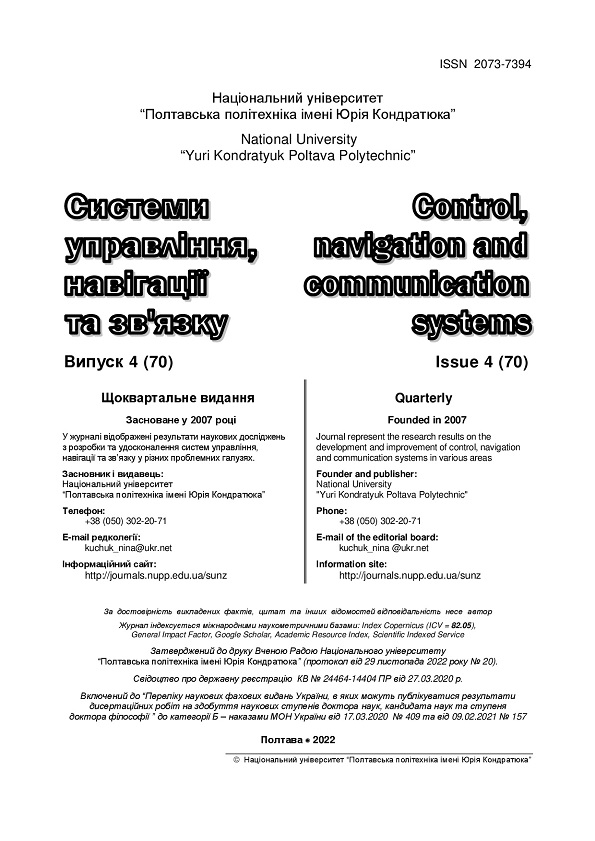МЕТОД ІМІТАЦІЙНОГО МОДЕЛЮВАННЯ ТРАФІКУ КОМП’ЮТЕРНОЇ МЕРЕЖІ З ФРАКТАЛЬНИМИ ВЛАСТИВОСТЯМИ
DOI:
https://doi.org/10.26906/SUNZ.2022.4.075Ключові слова:
комп’ютерні мережі, мережевий трафік, фрактальна розмірність, марківські процеси, імітаційне моделювання, програмна імітаційна модельАнотація
Метою даної роботи є створення методу імітаційного моделювання трафіку комп’ютерної мережі з фрактальними властивостями для тестування мережевих алгоритмів та протоколів. Об’єктом дослідження є процес імітаційного моделювання мережевого трафіку. Предметом дослідження є методи та алгоритми моделювання часового ряду з фрактальними властивостями. В наш час для математичного опису телекомунікаційних процесів використовують математичні моделі самоподібного часового ряду. В більшості випадків для самоподібного трафіку, передбачення параметрів за якістю обслуговування QoS, аналітичні вирази побудувати не вдається, або такі перетворення можливо побудувати для занадто специфічних ситуацій, тому переважно аналітичні викладки є недоцільними. З цієї причини для визначення основних показників якості обслуговування, таких як джитер, запізнення, середня кількість відмов, та інших, використовують імітаційне моделювання за допомогою генераторів самоподібного трафіку. Це призводить до потреб в простих, з точки зору кількості обчислень, генераторів самоподібного трафіку з керованими фрактальними властивостями, які б давали числові послідовності з властивостями якомога ближчими до властивостей реального трафіку телекомунікаційної мережі, що досліджується. У даній роботі запропоновано метод імітаційного моделювання трафіку комп’ютерної мережі з фрактальними властивостями. Для генерації трафіку використано теорію фрактального аналізу та теорію марківськіх процесів. Даний метод може бути частиною програмної імітаційної моделі комп’ютерної мережі, яку в свою чергу можна використати для тестування мережевих алгоритмів та протоколів. Також розроблену імітаційну модель мережевого трафіку планується використовувати у подальшому для тестування якості методів визначення фрактальної розмірності часових рядів, а також для прогнозування завантаженості мережевих пристроїв у комп’ютерних мережах.Завантаження
Посилання
Zmeškal O., Nežádal M., Komendová B., Julínek M., Bžatek T. (2003), “Fractal analysis of printed structure images”,Institute of Physical and Applied Chemistry, of the methods used to perform analysis listed above, Brno University of Technology, Brno, Czech Republic.
Leland W., Taqqu М., Willinger W. (1997), “On the self-similar nature of IP-trafic”, IEEE/ACM Transactions on Networking, № 3, P. 423-431.
Кучук Г.А. (2005), “Метод дослідження фрактального мережного трафіка”, Системи обробки інформації, Вип. 5 (45), Харків, Україна, С. 74-84.
Кучук Г.А., Можаєв О.О., Воробйов О.В. (2006), “Аналіз та моделі самоподібного трафіка”, Авиационно-космическая техника и технология, № 9(35), С. 173-180.
Drieieva H., Drieiev O., Meleshko Ye., Yakymenko M., Mikhav V. (2022), “A method of determining the fractal dimension of network traffic by its probabilistic properties and experimental research of the quality of this method”, CEUR -WS, Vol.3171, Gliwice, Poland, R. 1694-1707, available at: http://ceur-ws.org/Vol-3171/paper120.pdf
Meleshko Ye., Drieiev O., Yakymenko M., Lysytsia D. (2020), “Developing a model of the dynamics of states of a recommendation system under conditions of profile injection attacks”, Eastern-European Journal of Enterprise Technologies, Vol. 4, No. 2(106), pp. 14-24, available at: https://www.scopus.com/record/display.uri?eid=2-s2.0-85096707995&origin=resultslist
Meleshko Ye., Raskin L., Semenov S., Sira O. (2019), “Methodology of probabilistic analysis of state dynamics of multidimensional semi-Markov dynamic systems”, Eastern-European Journal of Enterprise Technologies, Vol. 6, No. 4(102), pp. 6-13, available at: https://www.scopus.com/record/display.uri?eid=2-s2.0-85078054250&origin=resultslist
Dimitrakos TD, Kyriakidis EG (2008), “A semi-Markov decision algorithm for the maintenance of a production system with buffer capacity and continuous repair times”, International Journal of Production Economics, Vol. 111(2), pp. 752-762, doi: https://doi.org/10.1016/ j.ijpe .2007.03.010
Li Q.-L., Lui JCS, (2014), “Block-structured supermarket models, Discrete Event Dynamic Systems”, Vol. 26(2), pp. 147-182, doi: https:// doi.org/10.1007/s10626-014-0199-1
Okamura H., Miyata S., Dohi T., (2015), “A Markov Decision Process Approach to Dynamic Power Management in a Cluster System”, IEEE Access, Vol. 3, pp. 3039-3047, doi: https://doi.org/10.1109/access.2015.2508601
Li Q.-L. (2016), “Nonlinear Markov processes in large networks”, Special Matrices, Vol. 4(1), doi: https://doi.org/10.1515/spma-2016-0019
Feinberg EA, Yang F., (2015), “Optimal pricing for a GI/M/k/N queue with several customer types and holding costs”, Queuing Systems, Vol. 82(1-2), pp. 103-120, doi: https://doi.org/10.1007/s11134-015-9457-7
Ушанев К.В. (2015), “Имитационные модели системы массового обслуживания типа Pa/M/1, H2/M/1 и исследование на их основе качества обслуживания трафика со сложной структурой”, Системы управления, связи и безопасности. 2015, №4, С.217-251.
Добровольский Е.В., Нечипорук О.Л. (2005), “Моделирование сетевого трафика с использованием контекстных методов”, Наукові праці Одеської національної академії зв'язку імені О. С. Попова, Одеса, Україна, № 1, С.24-32.
Семенов С.Г., Мелешко Є.В., Ілюшко Я.В. (2011), “Математическая модель мультисервисного канала связи на основе экспоненциальной GERT-сети”, Системи озброєння і військова техніка, Харків, Україна, № 3(27), С.64-67.
Radivilova T., Ibrahim Y. Daradkeh, Kirichenko L. (2018), “Development of QoS Methods in the Information Networks with Fractal Traffic”, International Journal of Electronics and Telecommunications, 64 (1), Р. 27-32.
Barat M., Joveini Z., Sadri J., Khoushhal H.A. (2018), “Fractal Modeling of Big Data Networks”, International Conference on Pattern Recognition and Artificial Intelligence (ICPRAI 2018), Canada, Montreal: Concordia University, Р. 1-4.
Jiang D., Huo L., Li Y. (2018), “Fine-granularity inference and estimations to network traffic for SDN”, PLoS ONE, No13(5), doi: doi.org/10.1371/journal.pone.0194302
Кучук Г.А, Можаєв О.О., Воробйов О.В. (2007), “Прогнозирование трафика для управления перегрузками интегрированной телекоммуникационной сети”, Радіоелектронні і комп’ютерні системи, № 8, С. 261-271, available at: http://nbuv.gov.ua/UJRN/recs_2007_8_48
Кучук Г.А., Можаєв О.О., Воробйов О.В. (2006), “Аналіз та моделі самоподібного трафіка”, Авиационно-космическая техника и технология, № 9, С. 173-180, available at: http://nbuv.gov.ua/UJRN/aktit_2006_9_35
Haffey M., Arlitt M., Williamson C. (2018), “Modeling, Analysis, and Characterization of Periodic Traffic on a Campus Edge Network”, 2018 IEEE 26th International Symposium on Modeling, Analysis, and Simulation of Computer and Telecommunication Systems (MASCOTS), p. 170-182.
Kirichenko L., Radivilova T., Bulakh V. (2018), “Machine Learning in Classification Time Series with Fractal Properties”, available at: https://www.researchgate.net/publication/329973801_Machine_Learning_in_Classification_Time.
Drieieva H., Smirnov O., Drieiev O., Polishchuk Y., Brzhanov R., Aleksander M. (2020), “Method of Fractal Traffic Generation by a Model of Generator on the Graph”, COAPSN, CEUR-WS, Vol . 2616, Lviv, Ukraine, available at: http://ceur-ws.org/Vol-2616/paper31.pdf
Drieieva H., Drieiev O., Meleshko Ye., Yakymenko M., Mikhav V. (2022), “A Method of Determining the Fractal Dimension of Network Traffic by Its Probabilistic Properties and Experimental Research of the Quality of This Method”, CEUR-WS, Vol. 3171, Gliwice, Poland, Р. 1694-1707, available at: http://ceur-ws.org/Vol-3171/paper120.pdf




